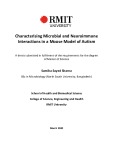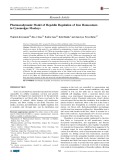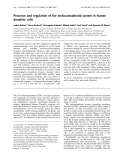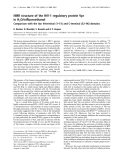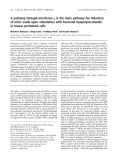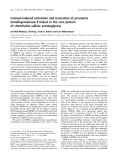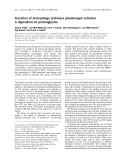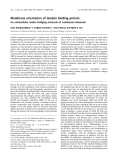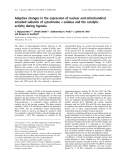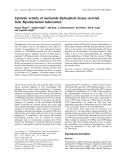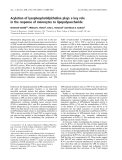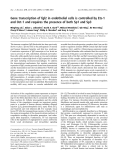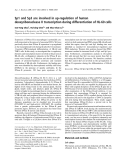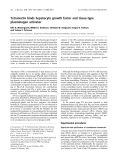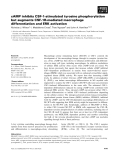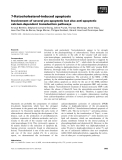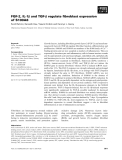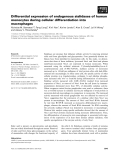
Macrophage
-
The aims of the study "Characterising microbial and neuroimmune interactions in a mouse model of autism" are threefold: i) To characterize the influence of the R451C mutation on caecal enteric neuron organization; ii) To characterize the influence of the R451C mutation on caecal patch macrophage density and morphology; iii) To assess for alterations in gut microbes in different regions of the GI tract in the NL3R451C mouse model of autism.
 83p
83p  runthenight04
runthenight04
 02-02-2023
02-02-2023
 8
8
 1
1
 Download
Download
-
Hepcidin (H25) is a hormone peptide synthesized by the liver that binds to ferroportin and blocks iron export. In this study, H25 was inhibited by administration of single and multiple doses of an anti-H25 monoclonal antibody Ab 12B9m in cynomolgus monkeys. The objective of this analysis was to develop a pharmacodynamic model describing the role of H25 in regulating iron homeostasis and the impact of hepcidin inhibition by Ab 12B9m. Total serum H25 and Ab 12B9m were determined in each animal. Corresponding measurements of serum iron and hemoglobin (Hb) were obtained.
 15p
15p  caothientrangnguyen
caothientrangnguyen
 09-05-2020
09-05-2020
 13
13
 1
1
 Download
Download
-
Cannabinoid receptors and their endogenous ligands, the endocannabinoids, have been detected in several blood immune cells, including monocytes/macrophages, basophils and lymphocytes. However, their presence in dendritic cells, which play a key role in the initiation and development of the immune response, has never been investigated.
 8p
8p  system191
system191
 01-06-2013
01-06-2013
 29
29
 4
4
 Download
Download
-
The human immunodeficiency virus type 1, HIV-1, genome encodes a highly conserved regulatory gene product, Vpr (96 amino acids), which is incorporated into virions in quantities equivalent to those of the viral Gag protein. In infected cells, Vpr is believed to function during the early stages of HIV-1 replication (such as transcription of the proviral genome and migration of preintegration nuclear complex), blocks cells in G2 phase and triggers apoptosis.
 10p
10p  system191
system191
 01-06-2013
01-06-2013
 46
46
 4
4
 Download
Download
-
Nitrogen monoxide (NO) is a cytotoxic effector molecule produced by macrophages that results in Fe mobilization from tumour target cells which inhibits DNA synthesis and mitochondrial respiration. It is well known that NO has a high affinity for Fe, and we showed that NO-mediated Fe mobilization is markedly potentiated by glutathione (GSH) generated by the hexose monophosphate shunt [Watts, R.N. & Richardson, D.R. (2001) J. Biol. Chem. 276, 4724–4732]. We hypothesized that GSH completes the coordination shell of an NO–Fe complex that is released from the cell.
 10p
10p  research12
research12
 01-06-2013
01-06-2013
 49
49
 3
3
 Download
Download
-
Production of nitric oxide (NO) in response to bacterial lipopolysaccharide (LPS) was investigated using cultures of mouse peritoneal exudate cells (PEC) and the macrophage cell line RAW264.7. In the presence of anti-(interferon-c) (IFN-c), NO production was markedly suppressed in the PEC culture but not in the RAW264.7 culture. In the PEC culture, LPS induced both IFN-cproduction and activation of IFNresponse factor-1, which leads to the gene expression of inducible NO synthase, but neither was induced in the culture of RAW264.7 cells....
 10p
10p  tumor12
tumor12
 20-04-2013
20-04-2013
 30
30
 4
4
 Download
Download
-
In the leukemic macrophage cell-line THP-1, a fraction of the secreted matrix metalloproteinase 9 (MMP-9) is linked to the core protein of chondroitin sulfate proteoglycans (CSPG). Unlike the monomeric and homodimeric forms of MMP-9, the addition of exogenous CaCl2 to the proMMP-9/CSPG complex resulted in an active gelatinase due to the induction of an autocatalytic removal of the N-terminal prodomain.
 12p
12p  tumor12
tumor12
 20-04-2013
20-04-2013
 36
36
 3
3
 Download
Download
-
The importance of proteoglycans for secretionof proteolytic enzymes was studied in the murine macrophage cell line J774. Untreated or 4b-phorbol 12-myristate 13-acetate (PMA)-stimulated macrophages were treated with hexyl-b-D-thioxyloside to interfere with the attachment of glycosaminoglycan chains to their respective protein cores. Activation of the J774 macrophages with PMA resulted in increased secretion of trypsin-like serine proteinase activity.
 10p
10p  tumor12
tumor12
 20-04-2013
20-04-2013
 35
35
 3
3
 Download
Download
-
Earlier we presented several lines of evidence that a 67-kDa laminin binding protein (LBP) inLeishmania donovani,that is different from the putative mammalian 67-kDa laminin receptor, may play an important role in the onset of leish-maniasis, as these parasites invade macrophages in various organs after migrating through the extracellular matrix. Here we describe the membrane orientation of thisLeish-manialaminin receptor.
 8p
8p  tumor12
tumor12
 20-04-2013
20-04-2013
 45
45
 4
4
 Download
Download
-
The effects of physiologically relevant hypoxia on the catalytic activity of cytochromecoxidase (CytOX), mito-chondrial gene expression, and both nuclear and mito-chondrial encoded CytOX mRNA levels were investigated in murine monocyte macrophages, mouse C2C12 skeletal myocytes and rat adrenal pheochromocytoma PC12 cells. Our results suggest a coordinated down regulation of mito-chondrial genome-coded CytOX I and II and nuclear genome-codedCytOX IV andVbmRNAs during hypoxia.
 9p
9p  tumor12
tumor12
 20-04-2013
20-04-2013
 35
35
 3
3
 Download
Download
-
Pathogenicity ofMycobacterium tuberculosisis closely rela-ted to its ability to survive and replicate in the hostile envi-ronment of macrophages. For some pathogenic bacteria, secretion of ATP-utilizing enzymes into the extracellular environment aids in pathogen survival via P2Z receptor-mediated, ATP-induced death of infected macrophages. A component of these enzymes is nucleoside diphosphate kinase (Ndk). Thendkgenewas cloned fromM. tuberculosis H37Rv and expressed inEscherichia coli.
 10p
10p  tumor12
tumor12
 20-04-2013
20-04-2013
 42
42
 3
3
 Download
Download
-
Macrophages at an inflammatory site release massive amounts of proteolytic enzymes, including lysosomal cys-teine proteases, which colocalizewith their circulating, tight-binding inhibitors (cystatins, kininogens), so modifying the protease/antiprotease equilibrium in favor of enhanced proteolysis. We have explored the ability of human cath-epsins B, KandL to participate in the production of kinins, using kininogens and synthetic peptides that mimic the insertion sites of bradykinin on human kininogens....
 8p
8p  tumor12
tumor12
 20-04-2013
20-04-2013
 46
46
 5
5
 Download
Download
-
Mononuclear phagocytes play a pivotal role in the pro-gression of septic shock by producing tumor necrosis factor-a(TNF-a) andother inflammatorymediators in response to lipopolysaccharide (LPS) fromGram-negativebacteria.Our previous studies have shown monocyte and macrophage activationcorrelatewithchanges inmembranephospholipid composition, mediated by acyltransferases. Interferon-c (IFN-c), which activates and primes these cells for enhanced inflammatory responses to LPS, was found to selectively activate lysophosphatidylcholine acyltransferase (LPCAT) (P...
 7p
7p  fptmusic
fptmusic
 16-04-2013
16-04-2013
 39
39
 2
2
 Download
Download
-
The immune coagulant fgl2/fibroleukin has been previously shown to play a pivotal role in the pathogenesis of murine and human fulminant hepatitis and fetal loss syndrome. Constitutive expression of fgl2 transcripts at low levels are seen in cytotoxic T cells, endothelial, intestinal and tropho-blast cells, while specific factors (such as virus and cytokines) are required to induce high levels of fgl2 expression in other cell types including monocytes/macrophages.
 13p
13p  fptmusic
fptmusic
 16-04-2013
16-04-2013
 37
37
 5
5
 Download
Download
-
Expression of DNase II in macrophages is potentially cru-cially important in the removal of unwantedDNA.We have previously shown that DNase II expression is up-regulated at the transcriptional level during the phorbol 12-myristate-13-acetate (PMA)-induced differentiation of HL-60 and THP-1 cells. In this study, we investigated thecis-regulatory elements and transcription factors involved in this process in HL-60 cells.
 8p
8p  fptmusic
fptmusic
 16-04-2013
16-04-2013
 48
48
 3
3
 Download
Download
-
In the search for new ligands for the plasminogen kringle 4 binding-protein tetranectin, it has been found by ligand blot analysis andELISAthat tetranectinspecificallybound to the plasminogen-like hepatocyte growth factor and tissue-type plasminogen activator.The dissociation constants of these complexes were found to be within the same order of mag-nitude as the one for the plasminogen-tetranectin complex. The study also revealed that tetranectin did not interact with the kindred proteins: macrophage-stimulating protein, urokinase-type plasminogen activator and prothrombin....
 5p
5p  fptmusic
fptmusic
 16-04-2013
16-04-2013
 51
51
 4
4
 Download
Download
-
Macrophage colony stimulating factor (M-CSF) or CSF-1 controls the development of the macrophage lineage through its receptor tyrosine kin-ase, c-Fms. cAMP has been shown to influence proliferation and differenti-ation in many cell types, including macrophages. In addition, modulation of cellular ERK activity often occurs when cAMP levels are raised.
 12p
12p  fptmusic
fptmusic
 11-04-2013
11-04-2013
 46
46
 3
3
 Download
Download
-
Oxysterols, and particularly 7-ketocholesterol, appear to be strongly involved in the physiopathology of atherosclerosis. These molecules are suspected to be cytotoxic to the cells of the vascular wall and mono-cytes⁄macrophages, particularly by inducing apoptosis. Previous studies have demonstrated that 7-ketocholesterol-induced apoptosis is triggered by a sustained increase of cytosolic-free Ca 2+ , which elicits the mitochondrial pathway of apoptosis by activation of the calcium-dependent phosphatase calcineurin, leading to dephosphorylation of the ‘BH3 only’ protein BAD....
 12p
12p  fptmusic
fptmusic
 11-04-2013
11-04-2013
 33
33
 2
2
 Download
Download
-
Growth factors, including fibroblast growth factor-2 (FGF-2) and transform-ing growth factor-b(TGF-b) regulate fibroblast function, differentiation and proliferation. S100A8 and S100A9 are members of the S100 family of Ca 2+ -binding proteins and are now accepted as markers of inflammation. They are expressed by keratinocytes and inflammatory cells in human⁄murine wounds and by appropriately activated macrophages, endothelial cells, epithelial cells and keratinocytesin vitro.
 17p
17p  awards
awards
 06-04-2013
06-04-2013
 35
35
 2
2
 Download
Download
-
Sialidases are enzymes that influence cellular activity by removing terminal sialic acid from glycolipids and glycoproteins. Four genetically distinct sia-lidases have been identified in mammalian cells. In this study, we demon-strate that three of these sialidases, lysosomal Neu1 and Neu4 and plasma membrane-associated Neu3, are expressed in human monocytes.
 12p
12p  awards
awards
 06-04-2013
06-04-2013
 30
30
 4
4
 Download
Download
CHỦ ĐỀ BẠN MUỐN TÌM









